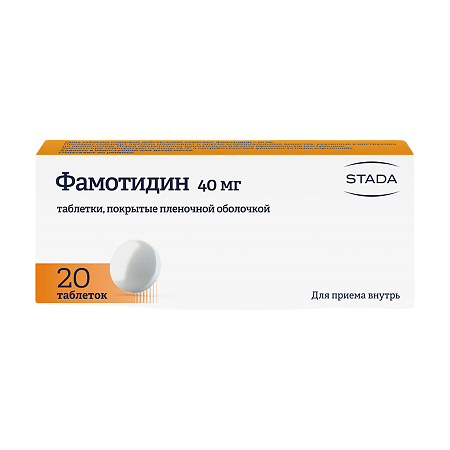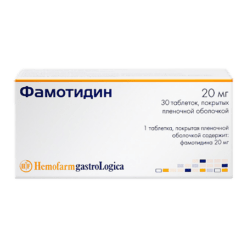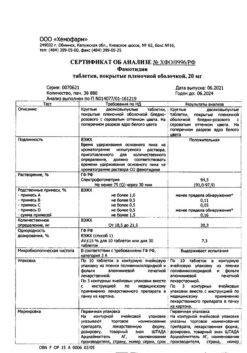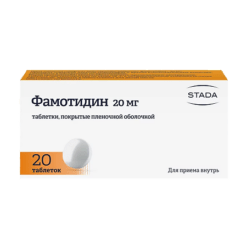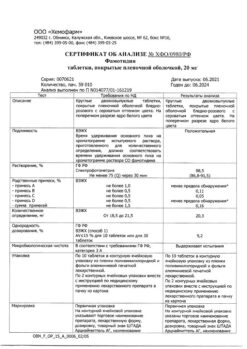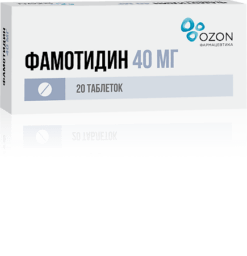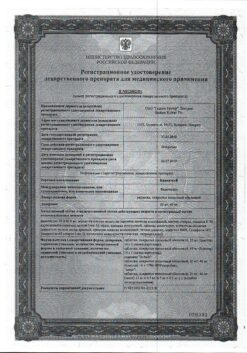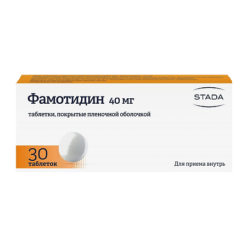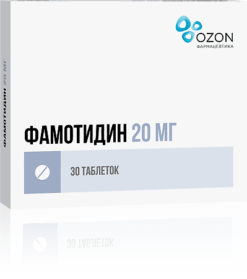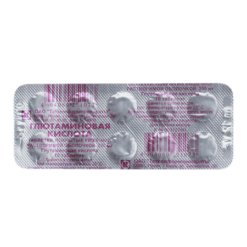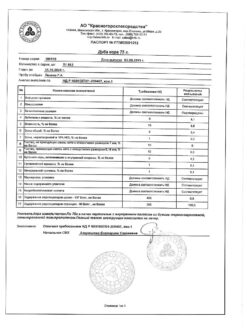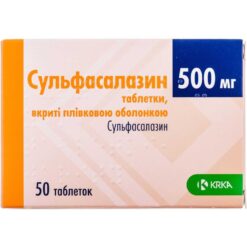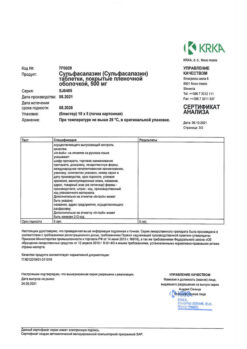No products in the cart.
Famotidine, 40 mg 20 pcs
€2.13 €1.77
EAN: 4607143560444
SKU: 204742
Categories: Medicine, Stomach, intestines, liver, Ulcer and gastritis
Description
Famotidine is an anti-ulcer.
Blocks histamine H2 receptors, inhibits the production of hydrochloric acid.
Indications
Indications
Active ingredient
Active ingredient
Composition
Composition
1 tablet contains:
The active ingredient:
Famotidine 40 mg;
Excipients:
Corn starch,
Microcrystalline cellulose,
Silicon dioxide,
Talc,
Magnesium stearate,
Sodium croscarmellose;
Shell composition:
Hypromellose,
Macrogol 6000,
Titanium dioxide (E171),
Talc,
Dye iron oxide brown.
How to take, the dosage
How to take, the dosage
Orally, swallowed whole (without chewing), with plenty of water.
In gastric and duodenal ulcer in the acute phase, symptomatic ulcers, erosive gastroduodenitis – usually 20 mg twice a day or 40 mg once a day at night.
If necessary, the daily dose can be increased to 80-160 mg. The course of treatment is 4-8 weeks.
In case of dyspepsia associated with increased secretory function of the stomach, 20 mg 1-2 times a day.
In order to prevent recurrence of peptic ulcer disease – 20 mg once a day before going to bed.
In reflux esophagitis – 20-40 mg 2 times a day for 6-12 weeks.
In Zollinger-Ellison syndrome the dose of the drug and the duration of treatment are determined individually. The initial dose is usually 20 mg every 6 hours and may be increased to 160 mg every 6 hours.
To prevent aspiration of gastric juice during general anesthesia, 40 mg in the evening and/or in the morning before surgery.
In case of renal insufficiency (at Cl creatinine3 mg/100 ml) the daily dose of the drug should be reduced to 20 mg.
Interaction
Interaction
Antacids interfere with absorption (a break of at least 1-2 hours between intake of antacids and famotidine is recommended).
Special Instructions
Special Instructions
Before starting treatment, the possibility of malignant disease of the esophagus, stomach, or duodenum should be excluded.
Famotidine, like all H2-histamine receptor blockers, should not be abruptly withdrawn (ricochet syndrome).
In long-term treatment in weakened patients with stress, bacterial lesions of the stomach with subsequent spread of infection are possible.
The drug should be taken 2 hours after taking itraconazole, ketoconazole, atazanavir, cefuroxime, dasatinib to avoid significantly reducing their absorption.
A gap between intake of antacids, sucralfate and famotidine should be at least 1-2 hours.
H2-histamine receptor blockers may counteract the effects of pentagastrin and histamine on gastric acid-producing function, so the use of H2-histamine receptor blockers is not recommended in the 24 hours prior to the test.
Histamine receptor blockers may inhibit the skin reaction to histamine, resulting in false negatives
(Before diagnostic skin tests for immediate-type allergic skin reactions, the use of H2-histamine receptor blockers should be stopped).
At the time of treatment, avoid eating foods, drinks, and other medications that may cause gastric mucosal irritation.
Patients with burns may need to increase the dose of the drug due to increased clearance.
The effectiveness of the drug in inhibiting nocturnal gastric acid secretion may be reduced by smoking.
Impact on the ability to drive and operate machinery
With regard to the possibility of developing side effects on the central nervous system, the question of whether to engage in potentially hazardous activities requiring increased attention and
fast psychomotor reactions should only be decided after assessing the patient’s individual response to the drug.
Synopsis
Synopsis
Contraindications
Contraindications
With caution: hepatic and/or renal insufficiency, cirrhosis with portosystemic encephalopathy (in anamnesis), immunodeficiency, childhood age.
Side effects
Side effects
The digestive system: dry mouth, nausea, vomiting, abdominal pain, rarely – loss of appetite, increased activity of “liver” transaminases, constipation, diarrhea, jaundice, hepatocellular, cholestatic or mixed hepatitis, in some cases may develop acute pancreatitis.
Nervous system disorders: headache, dizziness; asthenia, drowsiness, insomnia, anxiety, nervousness, depression, psychosis; there have been described cases of hallucinations, confusion, blurred vision, hyperthermia.
Cardiovascular system disorders: very rarely – decreased blood pressure, bradycardia, atrioventricular block, arrhythmia, vasculitis.
Allergic reactions: skin rash, itching, bronchospasm, angioedema, erythema multiforme, exfoliative dermatitis, Stevens-Johnson syndrome, toxic epidermal necrolysis, anaphylactic shock.
Hematopoietic organs: rarely – neutropenia, leukopenia, thrombocytopenia, hemolytic anemia; in single cases – agranulocytosis, pancytopenia, bone marrow aplasia.
With the reproductive system: in prolonged use of high doses – hyperprolactinemia, gynecomastia, amenorrhea, decreased libido, impotence.
Others: rarely fever, arthralgia, myalgia, tinnitus, dry skin, alopecia.
Overdose
Overdose
Symptoms: vomiting, motor agitation, tremor, decreased blood pressure, tachycardia, collapse.
Treatment: gastric lavage, symptomatic and supportive therapy, hemodialysis.
Pregnancy use
Pregnancy use
It penetrates through the placenta. Use during pregnancy is possible only if the benefit to the mother exceeds the risk to the fetus.
It penetrates into breast milk; if it is necessary to use during lactation, either discontinue the drug or breastfeed.
Similarities
Similarities
Additional information
| Shelf life | 3 years |
|---|---|
| Conditions of storage | In a place protected from light and moisture, at 15-25 °C |
| Manufacturer | Chemopharm LLC, Russia |
| Medication form | pills |
| Brand | Chemopharm LLC |
Other forms…
Related products
Buy Famotidine, 40 mg 20 pcs with delivery to USA, UK, Europe and over 120 other countries.

